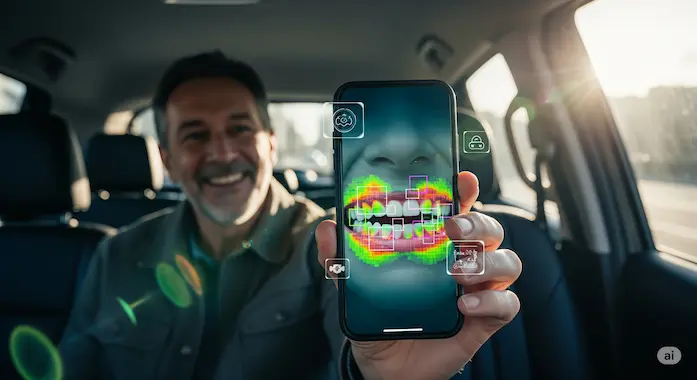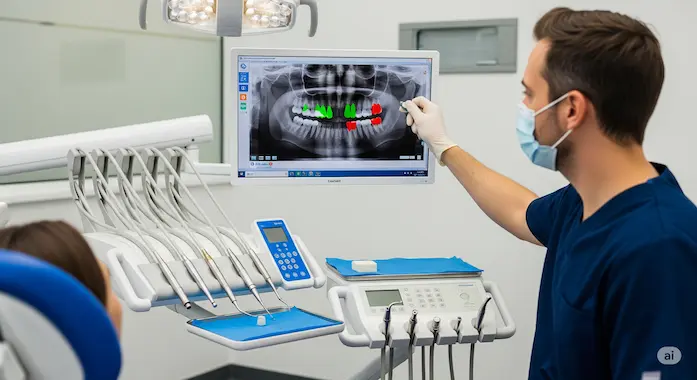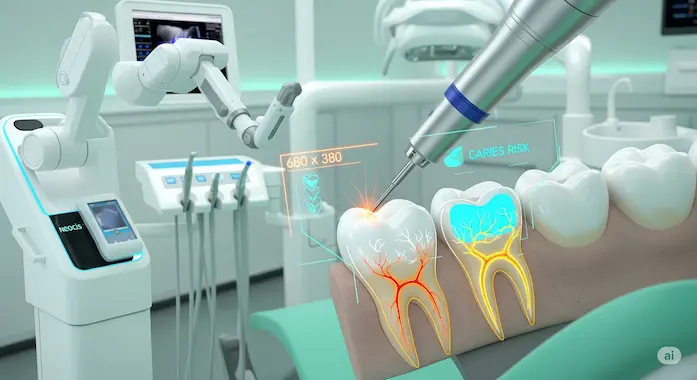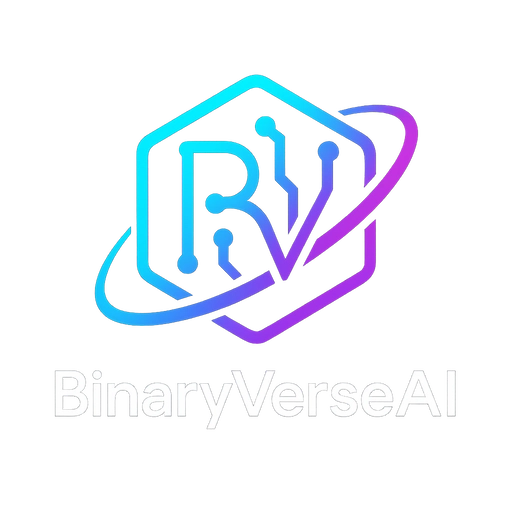Written by Dr. Syed Ali, BDS
Dr. Syed Ali is a practicing dentist at IMDC – Islamabad Medical & Dental College. With a strong interest in clinical innovation and AI-assisted diagnostics, he offers a practitioner’s perspective on how artificial intelligence is transforming modern dentistry. As a guest contributor, he bridges real-world dental care with the frontier of medical technology.
1. Selfies, but for Molars
It is a strange feeling to point your phone inside your mouth and hear a cold synthetic voice predict whether your enamel is cracking. Stranger still, it often feels right. AI in dentistry has reached that uncanny moment when a photo snapped in a rideshare can trigger a push notification telling you to book a cleaning. The convenience looks trivial on the surface, yet beneath the polished user interface lives a decade of algorithmic progress, cloud infrastructure, and orthodontic frustration that finally found each other.
In today’s post we explore the most recent benchmark in AI in dentistry, a study from BDJ Open whose title reads like a punchline: “Smile, You’re Being Diagnosed.” The paper pits a bespoke convolutional neural network against fifty-one living, breathing dentists. If you think the professionals won by a mile, prepare to be surprised. The margin was thinner than dental floss, and the implications cut much deeper.
Table of Contents
2. The Access Abyss

Ask anyone in the United Kingdom about getting an appointment and you will hear the same groan. Waiting lists stretch into the horizon. That delay is not just inconvenient. According to a YouGov poll, one in five patients sits in preventable pain while slots remain jammed. The logjam turns small plaque patches into costly crowns, and it keeps clinicians racing from operatory to operatory without time for prevention.
Enter AI in dentistry, a pragmatic answer hiding in clear sight. The application of AI in dentistry can triage, pre-screen, and even prioritize cases before a patient ever reaches the chair. A single well-trained model can push a suspicious white spot to the top of a dentist’s schedule while letting routine check-ups wait a few extra days. That adjustment reshapes the entire experience, not through more drills, but by smarter allocation of attention.
3. Why Teeth Are a Perfect Training Set
Deep learning systems love structure. Teeth provide exactly that. Incisors appear where incisors belong. Bicuspids look like squat pyramids. Gingival tissue hugs every crown in a predictable pastel. When you combine that anatomical consistency with millions of smartphone photos, you end up with an embarrassment of labeled riches. This symmetry explains why image recognition blossomed early in radiology and now overflows into gingival analysis.
AI in dentistry research has capitalized on this treasure. The model behind today’s study consumed five thousand annotated images. That dataset is meager compared with ImageNet, but plentiful enough to teach a network how to distinguish calculus from cheesecake crumbs. During training, every pixel mattered. Bounding boxes wrapped diseased areas at every angle, under every lighting mishap, from every brand of phone. By the end, the network could spot plaque on a molar rotated ninety degrees and lit by the flash from a budget handset.
4. The Neural Blueprint
The architects chose an SSD backbone. Single-Shot Detectors excel at real-time inference because they predict object classes and bounding box coordinates in one forward pass. On paper SSD looks humble next to Transformers, yet it holds a secret weapon—efficiency. That frugality makes SSD perfect for AI software for dental diagnosis running on consumer devices. A heavier model might shave another percentage point off error, but it would also drain a battery before you finish rinsing.
Training ran through one hundred thousand iterations. Classification loss dropped by ninety-one percent, localization loss by ninety-two, regularization by ninety-five. Those numbers tell a story of steady, relentless convergence. When the total loss finally leveled out, the team knew the model was ready for its trial by incisor.
5. The Cage Match: Silicon vs. Enamel Experts
Ninety unseen images entered the arena. Ten dentists first agreed on ground-truth labels, then fifty-one new clinicians and the AI faced off. The headline speaks for itself:
“Among the 51 participating dentists, clinicians correctly diagnosed 82.09 % of pathologies, while AI achieved 81.11 %.”
P-values of 0.63 and 0.80 confirmed that the differences were statistically invisible.
| Metric | Dentists (n = 51) | AI Model | Notes |
|---|---|---|---|
| Images with ≥ 1 correct pathology | 95.29% | 94.99% | Virtually tied |
| Pathology-level accuracy | 82.09% | 81.11% | Gap under 1% |
| Exact match with AI answer set | — | 81.02% | Agreement across cases |
Table 2 Where the algorithm stumbles (and overreaches)
| Pathology | Missed by AI | Over-diagnosed by AI |
|---|---|---|
| Gingivitis | 8.89% | 2.44% |
| Caries | 2.22% | 6.25% |
These numbers reveal two patterns. The network sometimes overlooks subtle gingivitis, yet it sounds the alarm on caries a bit too often. Both quirks offer valuable safety nets when paired with human judgment.
6. AI in Dentistry: Results That Speak for Themselves
After the direct face-off between machine and clinician, the researchers went deeper. They didn’t just ask, “Who got the right answer?” They asked, “How often did AI agree with dentists? When did either side catch at least one correct issue? What happens when multiple answers are acceptable?”
The results are revealing.
The study analyzed five diagnostic models across 90 intraoral images to evaluate how AI in dentistry performed under different scoring lenses. These models looked at exact matches, partial matches, and real-world scenarios where either party got something right—even if it wasn’t the full set of pathologies.
Here’s how the AI fared:
The researchers also plotted the accuracy of each model visually to highlight subtle differences between full matches and partial credit.
Comparison: AI vs Dentist Response Accuracy
| Questions | Answers |
|---|---|
| 1. Out of 90 questions, how many did AI get the same as the dentist? | 81.11% (73 out of 90) |
| 2. Out of 90 questions, how many times did AI choose at least 1 right answer? | 94.99% (48.44 out of 51) |
| 3. Out of 90 questions, how many dentists chose the same as Actual Pathologies? | 82.09% (41.87 out of 51) |
| 4. Out of 90 questions, how many times did the dentists choose at least 1 correct answer? | 95.29% (48.6 out of 51) |
| 5. Out of 90 questions, how many dentists chose the same as the AI (exact same)? | 81.02% (41.32 out of 51) |
What this tells us is simple: when you’re measuring AI in dentistry by the same standards as human experts, it’s a tight match. But when you’re evaluating it for its real-world utility—spotting at least one issue correctly—it performs just as reliably as human dentists. In fact, the hybrid metrics (DA1C and DA1AI) show the best accuracy of all.
That’s not just statistically interesting. It’s clinically relevant. These models reflect the actual messiness of practice, where partial correctness often helps steer a case in the right direction—even if not every lesion is caught.
7. Beyond the Number Game
Raw accuracy hides important nuance. The network overdiagnosed caries six percent of the time and underdiagnosed gingivitis almost nine percent. Humans displayed the opposite bias. Caries rarely slipped past a veteran clinician, but gingivitis sometimes did. The divergence is more than trivia. Cavities often demand immediate drilling or filling, so a conservative model suits that threshold. Gingivitis, while serious if ignored, develops in shades of red and can blur under poor lighting. The screen’s limited color gamut tricks silicon more readily than sclera and iris.
These quirks highlight a larger truth. The use of AI in dentistry is not about replacing clinicians. It is about complementing them. A camera never yawns, but it also never smells the sweet metallic scent of blood that warns of imminent infection. Pair the constancy of code with the intuition of a practitioner and you approach diagnostic harmony.
8. Where AI Already Lives in the Clinic

Skeptics often ask for concrete proof, not press releases. So let us tour some real-world examples of AI in dentistry already in operation:
- 1. Radiograph Triaging: Cloud platforms run algorithms that color-code suspicious radiolucencies on bite-wings before the dentist opens the file.
- 2. Clear Aligner Planning: Companies feed chest-high GPU clusters with thousands of STL scans to predict optimal attachment placement.
- 3. Periodontal Progress Tracking: Mobile apps compare weekly selfies, measure gum recession in pixels, and chart progression over time.
- 4. Caries Risk Analytics: Integration with electronic health records pulls diet, hygiene habits, and imaging into one dashboard. The software spits out a personalized risk index.
- 5. Voice-Guided Charting: AI converts spoken notes into structured periodontal charts in real time, freeing the assistant from keyboard duty.
Each case is another chapter in the ongoing saga of AI in dentistry, turning once manual rituals into collaborative tasks between human and silicon.
9. Advantages Hiding in Plain Sight
Why push forward when dentists are already skilled? Three reasons stand out.
Scalability. Human expertise scales linearly with training years. Algorithms scale logarithmically with GPUs. Once the model is tuned, duplicating it costs pennies.
Equity. Rural clinics often lack specialists. AI software for dental diagnosis travels over 4G in a heartbeat. A small town that cannot afford an oral pathologist can borrow one made of code.
Consistency. Fatigue, mood, and even last night’s study club can sway a clinician’s judgment. AI in dentistry delivers the same verdict at 2 am as at 2 pm.
These benefits coalesce into genuine public health impact. A screening algorithm that flags early-stage lesions can save a tooth and avoid a root canal years later.
10. The Other Side of the Coin
Every coin flips. Let us name the disadvantages of AI in dentistry before the marketing gloss blinds us.
- Data Bias: If your training images overrepresent young patients with perfect lighting, the model may stumble on older populations or darker mucosa.
- Privacy: Intraoral photographs reveal more than plaque. Metadata exposes location, and reflections can leak identity. Secure pipelines are mandatory.
- Regulatory Maze: Software that influences treatment decisions crosses into medical device territory. Compliance is complex.
- Overreliance: A junior dentist might defer to an algorithm without questioning false positives. Critical thinking must remain.
- Liability Fog: When a model mislabels a lesion and the patient suffers, who takes the blame?
These disadvantages of AI in dentistry do not negate the upside, but they demand sober planning.
11. Peering Inside the Black Box
One popular critique is explainability. Clinicians do not like shrugging when a patient asks, “Why does the computer think I have gingivitis?” Visualization tools offer a bridge. Grad-CAM overlays highlight regions that drove the prediction. Saliency maps render hot-spots in spectral colors. When the dentist sees a red glow around a marginal ridge, the trust gap narrows. Transparency turns artificial intelligence in dental diagnosis from mystic oracle into rational assistant.
12. Expanding the Dataset Universe
Five thousand images built a decent foundation, yet dentistry offers many scenes still unseen by silicon. Think of cracked amalgams, post-op sutures, orthodontic brackets covered in sauce from lunch. Crowded lower incisors in a teenager pose an occlusal maze, while tetracycline stains mimic caries under blue-white LEDs. The next wave of AI in dentistry research needs a million-image corpus. That scale brings rare pathologies into view and teaches the model to tell spinach from sub-gingival calculus at a glance.
Citizen science could help. Imagine a secure app that invites volunteers to donate anonymized tooth selfies. Gamification awards points for diverse angles and lighting. The wisdom teeth of the crowd feed the next generation of models.
13. Integrating With Chairside Hardware

Digital sensors already shoot radiographs that pop onto monitors in seconds. The leap is to bolt AI on top in real time. When an explorer taps a suspect fissure, the sensor frame from two seconds ago could update with a heat map. The dentist watches the gradient spread and decides whether to open the groove. This fusion of hands-on probing and algorithmic hindsight exemplifies the practical application of AI in dentistry.
Cone-beam CT is another frontier. Volumetric datasets are hefty, yet GPUs slice through voxels with ease. A cloud engine that filters nerve canals and sinus proximity could shorten implant planning by hours.
14. Case Study: Community Health Clinic
Consider a municipal clinic in Karachi. Two dentists juggle forty walk-ins daily. They recently installed software that performs AI in dentistry triage on images patients take in the waiting room. By the time someone sits, their record shows a likelihood score for caries and a gingivitis flag. The clinicians noticed that routine prophylaxis appointments now cluster midday, leaving complicated restorations in the morning when energy is high. Productivity rose twelve percent and patient satisfaction follows. Real numbers, real smiles.
15. Training the Next Generation
Dental schools feel the tremor. Curriculum committees debate whether histology hours should yield to Python electives. Students who once memorized nerve pathways now optimize decision thresholds. Some fear an erosion of foundational anatomy, yet the better analogy is pilots and autopilots. Understanding lift does not vanish because the plane can land itself. Instead, competence broadens. A future graduate will know how to calibrate an intraoral scanner and how to interpret its predictive overlay.
16. When The Algorithms Go Rogue
The darkest scenario surfaces when a bug or adversarial attack flips predictions. Researchers have shown how tiny pixel perturbations can fool image classifiers into seeing pandas as gibbons. Imagine a malicious actor tweaking dental images to hide early tumors, pushing them beyond detection. Cybersecurity now intertwines with periodontal care. A robust pipeline includes checksum verification, anomaly detection, and ongoing audits. Trust arrives on foot and leaves by Ferrari. AI in dentistry must earn it each visit.
17. Facing the Ethical Frontiers
Ethics extends beyond privacy. Socioeconomic bias slips in through unequal device quality. A model trained on high-resolution DSLR shots may balk at a grainy image from an inexpensive phone. Unless developers account for that spread, the benefits of AI in dentistry risk reinforcing existing gaps. Open datasets, transparent reporting, and inclusive sampling are the antidotes.
Informed consent also evolves. Patients deserve to know when an algorithm scrutinizes their premolars. Clear language beats technobabble. “We run your images through a secure program that helps spot problems early” suffices and respects autonomy.
18. Peeking Over the Horizon
The future of AI in dentistry looks almost science fiction. Imagine augmented reality glasses that project a caries risk map directly onto the tooth while you hold a mirror. Or a smart toothbrush that streams real-time plaque density to a dashboard, nudging technique with haptic pulses. Intraoral 3D printers might one day patch micro-fractures on the spot, guided by live segmentation algorithms.
On the research side, multimodal models could combine photographic data with saliva metabolomics, diet logs, and microbiome sequencing. The fusion yields a holistic profile that anticipates disease before enamel even starts to chalk.
19. The Economic Ripples
AI does not just shape clinical outcomes; it nudges the business model. Insurance companies smell predictive analytics and start adjusting premiums based on algorithmic risk scores. Manufacturers bundle AI modules with imaging hardware, creating subscription ecosystems. Venture capital pours into startups promising frictionless oral wellness platforms. The outcome hinges on whether stakeholders align around accessibility or chase profits without guardrails.
20. A Word to Practitioners
Dentists reading this may feel excitement mixed with dread. The best path forward is engagement. Start small. Pilot an inexpensive app that screens smartphone photos for plaque. Track false positives. Compare its output with your own notes. Over time you will build intuition about where AI helps and where it still fumbles. That hands-on familiarity beats any conference keynote.
Remember, the chairside relationship remains irreplaceable. Algorithms cannot hold a patient’s hand, calm fear, or weigh the social context of a treatment plan. Human judgment stays at the center, enriched by a silicon copilot that never blinks.
21. Closing the Loop
The BDJ Open study offers a snapshot, not the final portrait. Yet it confirms what many suspected. AI in dentistry has matured from prototype to practical partner. The application of AI in dentistry improves triage, strengthens preventive care, and widens access without diluting expertise. Yes, disadvantages of AI in dentistry linger, ranging from bias to litigation. Still, progress marches.
When your next checkup rolls around, do not be surprised if the hygienist greets you with a tablet displaying a traffic-light overlay of your bitewings. That overlay will be the sum of millions of pixels, thousands of GPU hours, and countless human annotations. It will also be the quiet signal that dentistry, an art once defined by touch and lamplight, now walks confidently into the era of code.
In that world, smiling for the camera might be the healthiest habit you adopt this year.
Citation:
Rathod, R., Dave, B., Dave, R., Zinzuwadia, H., & Bhavsar, R. (2025). Smile, you’re being diagnosed: Comparison of a convolutional neural network and dental professionals in classifying pathologies from intraoral images. BDJ Open. https://doi.org/10.1038/s41405-025-00336-6
Azmat — Founder of Binary Verse AI | Tech Explorer and Observer of the Machine Mind Revolution. Looking for the smartest AI models ranked by real benchmarks? Explore our AI IQ Test 2025 results to see how top models. For questions or feedback, feel free to contact us or explore our website.
- AI in dentistry: The use of machine learning and computer vision to assist with dental diagnosis, treatment planning, and workflow automation.
- Convolutional Neural Network (CNN): A type of deep-learning model that excels at recognizing patterns in images by sliding small filters across pixels, much like scanning tiles on a mosaic.
- Single Shot Detector (SSD): A real-time object-detection algorithm that predicts what an image contains and where those objects sit in a single forward pass, enabling quick on-device analysis.
- Bounding box: The rectangular outline an AI draws around a detected object or lesion, marking its position and size.
- Intraoral image: A photo taken inside the mouth, capturing teeth, gums, and soft tissues.
- Caries: Tooth decay caused by bacterial acids that demineralize enamel and dentin. Commonly called cavities.
- Gingivitis: Reversible inflammation of the gums, often presenting as redness or swelling along the gumline.
- Calculus (Tartar): Hardened plaque that adheres to teeth and can no longer be removed by brushing alone.
- Plaque: A sticky biofilm of bacteria, food particles, and saliva that forms on teeth and can lead to decay or gum disease.
- Underdiagnosis: When a disease or condition present in a patient is missed by a diagnostic method.
- Overdiagnosis: When a diagnostic method labels a problem that is not truly present, risking unnecessary treatment.
- P-value: A statistical measure that shows how likely it is that a result happened by chance. A lower value indicates stronger evidence against randomness.
- Radiolucency: A dark area on an X-ray where X-rays pass through less dense tissue, often signaling decay or bone loss.
- Grad-CAM (Gradient-weighted Class Activation Mapping): A visualization technique that highlights image regions most responsible for an AI model’s decision, helping clinicians understand why a prediction was made.
- Saliency map: A heat-map overlay that shows which pixels had the greatest influence on an AI’s output, revealing areas of interest or concern.
- Cone-beam CT (CBCT): A 3-D dental imaging modality that captures a cone-shaped beam of X-rays to produce high-resolution views of teeth, bone, and nerve pathways.
- Clear aligner: A transparent, removable orthodontic device that gradually shifts teeth into position, often planned with AI-driven simulations.
- Dental triage: The process of prioritizing patients based on the urgency of their oral health needs to optimize chair time and resources.
- Multimodal model: An AI system that processes and fuses several data types at once, such as images, text, and sensor data, to reach a more robust conclusion.
1. How is AI used in dentistry today?
AI in dentistry powers chairside image analysis, flags cavities on digital X-rays, predicts clear-aligner tooth movement, tracks periodontal changes in smartphone selfies, and streamlines appointment triage by ranking patient risk. These applications of AI in dentistry cut diagnosis time and boost preventive care accuracy.
2. Can artificial intelligence replace dentists in the future?
No. AI excels at pattern recognition and data crunching, yet it can’t perform clinical procedures, make nuanced treatment decisions, or deliver empathy. The use of AI in dentistry will remain collaborative, acting as a digital assistant while dentists handle hands-on work and patient counseling.
3. What are some real-world examples of AI in dental diagnosis?
Real-world AI software for dental diagnosis includes cloud tools that highlight radiolucencies on bite-wings, mobile apps that spot plaque and gingivitis in selfies, and cone-beam CT viewers that auto-trace nerve canals for implant planning. Practices already use these systems to shorten chair time and improve outcomes.
4. What are the disadvantages of AI in dentistry?
Key disadvantages of AI in dentistry include data bias that can miss conditions in diverse populations, privacy concerns over intraoral photos, high regulatory hurdles, and the risk of clinicians over-relying on algorithmic output. Robust oversight and diverse training datasets are essential safeguards.
5. What is the future of AI in dentistry?
The future of AI in dentistry points to real-time augmented-reality overlays during procedures, smart toothbrushes that stream plaque data, and multimodal models combining photos, saliva analyses, and health records for predictive care. Expect smarter workflows that keep dentists firmly in the loop while expanding access worldwide.


Fantastic beat I would like to apprentice while you amend your web site how could i subscribe for a blog site The account helped me a acceptable deal I had been a little bit acquainted of this your broadcast offered bright clear concept
Thank you so much for your kind words, Agnes! My team and I put a lot of effort into making sure each post delivers real value for your time. We truly appreciate your support. Feel free to bookmark the website, we’ll be launching a newsletter soon, and you’ll be the first to hear about it.